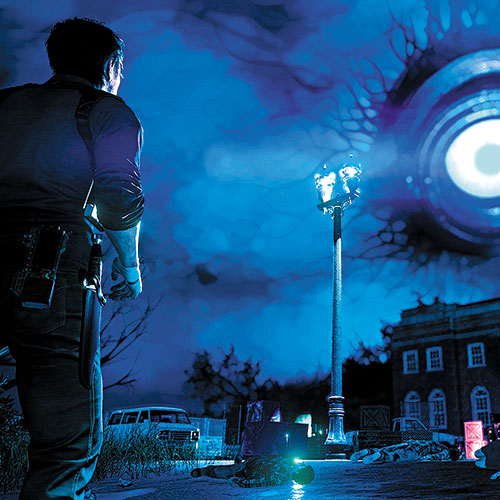Game Review: ‘The Evil Within 2,’ a diluted concoction

BY SURIEL VAZQUEZ | GAME INFORMER MAGAZINE (TNS)
Platform: PS4, Xbox One, PC
Genre: 1-Player, Action
Publisher: Bethesda Softworks
Developer: Tango Gameworks
ESRB: M, for mature
Ignoring the influence of “Resident Evil 4” on “The Evil Within” is impossible; survival-horror pioneer Shinji Mikami and developer Tango Gameworks iterated on the former’s combat, structure, and progression to make them fit their new franchise while upping the sense of scale and adding a few twists of their own. If the first entry worshipped at the altar of “Resident Evil 4,” then “The Evil Within 2” is polytheistic, borrowing more from several other games to introduce new scares into its mix. Though it finds a successful middle ground between horror and shooter, it doesn’t elevate itself above its inspirations, which makes for an enjoyable, if not unique, trek through a demented world.
Three years after the events of “The Evil Within,” Sebastian Castellanos is traumatized by his journey into STEM, a nightmare-inducing device that amalgamates the consciousness of everyone who enters it. During a late-night bender at a bar, he’s told his deceased wife and daughter are still alive, but he has to dive back into STEM to save them. The plot has its moments as reality becomes upended and characters grapple with the idea that they may not make it out STEM alive. Events are easier to follow this time around, though, as in many horror films, you can see when logic goes out the window in favor of creating specific scenarios.
During the first few hours, sneaking is almost mandatory, since combat is brutally difficult. You may be lucky to get one bullet for every few enemies as you make your way between checkpoints. Enemies also behave erratically and are quick enough to keep up, which means even stealth isn’t a foolproof approach. These are welcome curveballs to make sure players don’t get too comfortable; as soon as you’ve figured out the patterns of one enemy, you start seeing new enemies that throw a wrench in your strategy.
When you decide to expend your precious ammo, the shooting feels sluggish and unwieldy until you spend resources to steady your aim. Horror purists might say that’s key to building the tension the genre relies on, but lining up a headshot only to watch my bullet whizz by an enemy because I hadn’t accounted for where Sebastian’s trembling hands would sway isn’t tense — it’s aggravating.
You eventually find more weapons, ammo, and healing items than you know what to do with and a basic crafting system lets you turn found components into ammo. However, “The Evil Within 2” doesn’t make the turn from horror to action until much later, and I enjoyed the prolonged tension of thinking about my ammo and health in the long term. Even weak enemies can overwhelm you, and since you can only upgrade your ammo limit by finding hidden pouches, I was always counting rounds. I cursed the loss of every wasted bullet, but I appreciate that my actions carried weight and that I was rewarded for taking my time to sneak up on enemies, scouring the environment for resources, and contemplating how I’d upgrade my skills and guns.
Only in the last few hours did I feel I could handle whatever twisted monster the game would throw at me next, and I felt like I had earned that feeling. As it focuses more on barreling through bespoke encounters instead wading through large expanses, The “Evil Within 2” goes from plodding to intense. However, even as the combat and stealth became more satisfying and the speed picked up, I never escaped the nagging feeling that I was going through the motions instead of wondering what new environment or twist I’d see next.
Although most of your time includes running from one narrow corridor to the next, the game also has expansive, hub-like areas littered with enemies, supplies, and a few side quests. Although the side quests are worth tackling (one quest that initially felt like a drain led to a consistent source of supplies) you’re more likely to lose resources early on as enemies decimate you in groups. These sandbox areas are a bold step to expand the scope of the series but feel less focused, since sneaking by the same enemies multiple times between objectives damages the momentum.
The open-ended segments funnel into tighter, more curated levels, which feature a surprising amount of visual variety. Although most of this includes horror staples like abandoned mansions, dungeons, and various kinds of facilities, you get a few refreshing and impressive worlds with a more surreal flair. You never stay in one of these spaces for long, which helps stave off the sense that this is your hundredth time through a spooky underground laboratory.
These linear segments are also where you see the most homages to other games, such as a chapter dedicated to exploring the psyche of a murderous artist similar to “BioShock’s” Sander Cohen, or an otherworldly stealth sequence reminiscent of “Batman: Arkham Asylum’s Scarecrow” levels. These segments are well-executed, but few of them are surprising. They don’t twist the source material enough, making them feel more like rip-offs than homages. Most of the boss fights are similarly run-of-the-mill, never eliciting fear or forcing you to devise unique tactics; you lay into them with your shotgun. Seeing a group of regular enemies scared me more than meeting a boss.
“The Evil Within 2” is a solid horror game that expands the scope of the series to extend out of the shadow of a titan in the horror genre, even if it sometimes leans heavily on borrowed ideas. Its progression and difficulty curve create a satisfying loop that repays resourcefulness and strategy, but its set pieces and structure don’t build enough on the many ideas they borrow to make them feel new or interesting. The result is a ride that offers some fun thrills in the moment, but I don’t think I’ll lose too much sleep over these particular nightmares.











